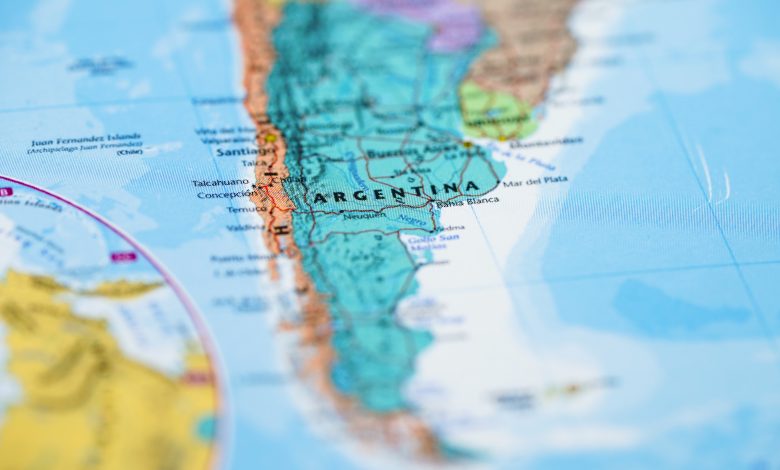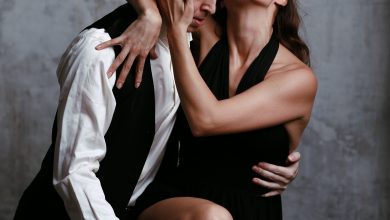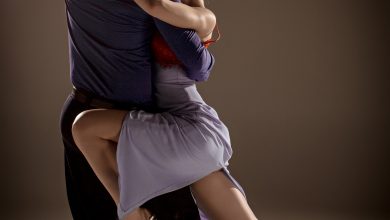Argentine Tango Terminology

Argentine tango terminology obviously developed in Spanish not English. Tango dancers throughout the world use mostly Spanish terms for many of the tango figures.
Overall Terms
Open Side versus Closed Side
The open side is the leader’s left and follower’s right side, and the closed side is the leader’s right side and the follower’s left side.
Parallel versus Cross Footwork
Parallel footwork takes place when the leader’s left leg is moving with the follower’s right leg, and similarly leader’s right leg with the follower’s left leg. Parallel is the most common style in argentine tango dancing, for example, as in the Basic Eight. Cross foot footwork takes place when the leader’s left leg is moving with the follower’s left leg, for example, in an ocho.
Pie active – Active foot
The foot which is about to walk or walking.
Pie soporte – Supporting foot
The foot which supports the body weight.
Posición Cero – Tango Close (Position Zero)
This is the process of collecting the feet at the end of a figure.
Dissociation – Contra Body
The tango position where there is dissociation between the torso / chest and the hips / legs.
Cadencia – weight change
The Cadencia is a weight change in place. It is used, for example, in Position 8 of the basic step. It can be used as subtle lead during breaks or to adjust the follower’s position.
Caminar (walk)
Salida
The beginning part of a figure, its starting-point, is called Salida (exit or beginning – as in “beginning of a journey”).
Resolucion
The end part of a figure is called Resolución.
Salida simple – Parallel System Salida
Beginning with strong contra body position of the upper torso and the leader’s right leg outside the follower (position 3 of the basic step).
Salida Cruzada – Cross System Salida
Beginning with the leader’s left leg outside the follower.
Syncopated Salida
Position 4 and 5 of the basic eight is done to the side.
Salida Americana
Lead initiating walk (called promenade) of the two dancers facing in the same direction.
Basic Step Terms
Paso – Basico – Basic Eight – Eight Count Basic – Eight Step Basic
The most common foundational figure taught to beginners.
Baldosa Box
A common figure taught to beginners. Similar to the Basic Eight but without the follower going to the Cross.
Cross – Cruz – Cruzada
Position where the follower’s left foot bears the weight and is tightly crossed over the right. The Cross occurs at step 5 in the Basic Eight.
Front Ocho – Forward Ocho – Ocho Adelante
The follower steps forward at right angle to the leader and then pivots 180 degrees.
Back Ocho – Backward Ocho – Ocho Atrás
The follower steps back at right angle to leader and then pivots 180 degrees.
Molinete / Giro
A circular grapevine (front, pivot, side, pivot, back, side) performed around the leader.
Stepover – Pasada – stop
Following a parada, the follower steps over the leader’s stopping foot.
Americana – Espejo
Couple in promenade position with the inside feet forward.
Cunita – Rock step – small cradle
Rocking or swaying to side, forward, or back. Comes from rocking a cuna (cradle)
Foot play
Steps involving foot play steps spice up the walk and elaborate the dance. These steps allow leaders and followers to challenge and surprise their tango partners and make the dance more fun. There are different shapes and sizes to these moves and their look depends on how crowded the venue.
Parada – Stop
The leader’s presses their foot against the follower’s foot so that the follower is led to a stop.
Sandwich – Sanguchito or Mordida
The leader’s left and right feet “sandwich” one of the follower’s feet. This normally follows a Parada.
Barrida – Arrastre – Drag – Sweep.
Normally, this involves the leader sweeping the follower’s foot, though sometimes the follower is led to sweep the leader’s foot.
Sacada – Entrada
One dancer displaces their partner’s leg which is just about to move. This is done by pressing low against calf or ankle, or high against thigh, but often has the appearance of contact rather than actual contact. Leader’s leg replaces partner’s unweighted leg position. Entrada doesn’t influence movement of the follower’s leg.
Bicicleta – Pedaling
Movement which resembles pedaling on a bicycle. Induced by the leader placing his foot under or to the side of the follower’s foot and lifting and lowering it.
Empujadita – Small push
Displacement of the follower’s leg by the leader’s leg.
Enganche – Leg wrap
One or both dancers wrap his or her leg around their partner’s leg. This wrapping is often sustained or frozen for a moment in time.
Gancho – hook
One dancer hooks her or his leg around their partner’s leg.
Piernazo – High leg wrap
Wrap or caress by follower’s leg raised up high and touching the partner’s waist or legs.
Intermediate Steps
Gancho – Hook
The follower flings their leg back between leader’s legs.
Wrap
The follower wraps a leg around the leader’s leg.
Boleo
Boleo shapes: low and high boleo; linear and circular boleo
Voleo Adelante – Front boleo
Sharp movement of the leg often interrupted or suspended. The woman’s lifts her foot from the floor and it flies to the side and wraps around her standing leg in front of her knee; boleos can be high (alto) or low (bajo). This move is alternatively named boleo and voleo in Spanish.
Voleo atrás – Back boleo
Sharp movement of the leg often interrupted or suspended initiated typically from a back ocho. The woman’s foot lifts from the floor and it flies to the side and wraps around her standing leg at the back of the knee. This move is alternatively named boleo and voleo in Spanish.
Voleo en linea – Linear voleo
Linear movement resulting in the leg’s suspension in the air at the back of (typically) her body.
Cruce or Crosses
Large groups of elegant tango figures include the use of the cross. The cross may come in a number of forms:
Cruce (cinco) Cross (regular cross, position five)
Crossed left foot in front of the right foot.
Cruce adelante – Front cross
Crossed one leg in front of the other.
Cruce atrás – Back cross
Crossed one leg in back of the other.
Cruce forzado – Forced cross
Crossed legs – induced by the lead.
Ocho
A figure “eight” traced on the floor by the follower’s feet. Large groups of elegant tango figures include the use of the ocho. The ocho may come in a number of forms:
Ocho Adelante – Forward ocho (front ocho)
Feet tracing a figure “eight” on the floor by the follower’s feet when she walks forward.
Ocho atrás – Back ocho
Feet tracing a figure “eight” on the floor by the follower’s feet when she walks back.
Ocho cortado – Cut ocho
Sudden change of direction leading the follower to cross during her forward walk.
Ocho milonguero – Non-pivot ocho (lazy ocho)
Ochos led and followed without substantial torso and hip pivoting.
Circular movements
Circular movements are inherent part of tango and have special importance in tango Vals. These include
Arroje – Push
Pushing follower away before leading giro.
Calesita – Carousel
Circular movement in which the leader pivots the follower around.
Giro – Turn
Giro is a turning step of the follower around the leader’s axis (called the molinete). A common name for this figure is the “grapevine”, alternating front and back steps connected by a side step. It is composed of several steps which complete a circle. One of the most common variants is composed of 4 steps (forward step, open step, back step, open step).
Media Luna – A half giro (half moon)
180 degree part of giro.
Molinete
The molinete translates as “mill” and it is the part of the mill in the center, the axis. In tango, it is the leader’s step, accompanying the follower’s giro or grapevine (see giro). In the molinete, the leader pivots on ball of their foot, so that the foot stays behind the body and the follower stays close. The leader may either pivot on one foot or two feet or alternate feet in time to the music, while staying on the ball of foot.
Vuelta
Circular movements such as “marionette”
Other Terms
Corrida – Run
A short sequence of steps.
Doble frente – Moving together in one direction.
The woman is in front of the man (see tango al reves style).
Elevacion Lifts
Espejo – Mirror step
Mirror steps or embellishments done by the man and the woman.
Friccion – Pulling
Pulling the woman typically dragged on her toes.
Pulpeadas – Leg entanglements, “sticky sacadas”
Class of trapped sacadas, wrapped sacadas, and carried ganchos.
Quebrada
Figure in which there is a sudden body twist or jerky move.
Palanca – Lever
Man helping the woman to jump or lift.
Patada – Kick
Kick between legs (by man or woman).
Rebotes – Switch step (bounce)
Change of direction, bounce. For example, after salida americana partners step forward and change direction to step back.
Salto, Saltitos – Jump, Small jump
Jump or small leaps or jumps
Sentada
Woman sits on leaders lap, hip, bended leg.
Tijera – Scissors
Small jump with scissoring step in between partner’s legs.
Soltada
Breaking embrace to execute a figure (such as a turn) on her or his own.
Off-axis Intermediate Steps
On and off axis
In Argentine tango, there are on axis and off axis positions. Body position where legs are approximately perpendicular to the floor is called on axis. Off axis positions are called apile (apilado, carpa, volcada) or colgada. The center of balance moves outside of one’s body in the case of the off axis moves. The follower is not balanced on their own axis but is leaning on (volcada) or hanging on (colgada) the leader.
Apile (volcada)
Off axis position in which both partners are leaning forward, may vary in degree of the tilt or shape. Many fluid and elegant tango figures can be danced in volcada position.
Colgada – Hanging
Off axis position in which both partners are leaning back with the follower being supported by the leader’s arms. The degree of tilt and body shape may vary. There is often centrifugal force pulling the partners apart.
Simple colgadas can be executed during woman’s step over leader foot.
There are a number of Colgada variations – hip under, straight, and exaggerated “hip under”.
Hip-under colgada describes a colgada with woman’s hips under her rib cage.
Plank or straight colgada is when her back tilt is without pronounced bend.
Side colgada
Off-axis move in which woman leans to the side while being supported by leader’s arms.
Volcada
When you can stand on your own feet without holding on to or leaning on someone in a stable position, you are in balance, you have your own axis.
If you are leaning on someone, you get into an off-balance or off axis position. If the leader moves away then the follower leans more. You are still in an off-balance position if the person stays in place allowing you to lean on them.
Off-axis move in which the woman leans forward and does forward or back cross or decorative figures with her legs. Volcadas can be done in open and close embrace. In case of closed embrace she is supported by the leader’s torso. In open embrace the leader’s arm provides support for the suspension.
Volcada (suspended)
Off-axis move in which the woman leans forward and her legs are opened and extended.
Volcada con adorno – Side volcada
Off-axis move in which the woman leans forward to the man’s side. She can do decorations with her leg.



